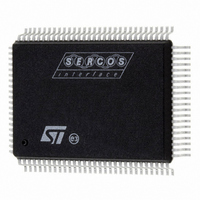ST92F150CV1QB STMicroelectronics, ST92F150CV1QB Datasheet - Page 311

ST92F150CV1QB
Manufacturer Part Number
ST92F150CV1QB
Description
MCU 8BIT 128K FLASH 100PQFP
Manufacturer
STMicroelectronics
Series
ST9r
Datasheet
1.ST92F150CV1TB.pdf
(429 pages)
Specifications of ST92F150CV1QB
Core Processor
ST9
Core Size
8/16-Bit
Speed
24MHz
Connectivity
CAN, I²C, LIN, SCI, SPI
Peripherals
DMA, LVD, POR, PWM, WDT
Number Of I /o
77
Program Memory Size
128KB (128K x 8)
Program Memory Type
FLASH
Eeprom Size
1K x 8
Ram Size
4K x 8
Voltage - Supply (vcc/vdd)
4.5 V ~ 5.5 V
Data Converters
A/D 16x10b
Oscillator Type
Internal
Operating Temperature
-40°C ~ 105°C
Package / Case
100-QFP
Processor Series
ST92F15x
Core
ST9
Data Bus Width
8 bit, 16 bit
Data Ram Size
6 KB
Interface Type
CAN, I2C, SCI, SPI
Maximum Clock Frequency
24 MHz
Number Of Programmable I/os
80
Number Of Timers
5 x 16 bit
Operating Supply Voltage
4.5 V to 5.5 V
Maximum Operating Temperature
+ 105 C
Mounting Style
SMD/SMT
Development Tools By Supplier
ST92F150-EPB
Minimum Operating Temperature
- 40 C
On-chip Adc
16 bit x 10 bit
Lead Free Status / RoHS Status
Lead free / RoHS Compliant
Other names
497-4882
Available stocks
Company
Part Number
Manufacturer
Quantity
Price
Company:
Part Number:
ST92F150CV1QB
Manufacturer:
STMicroelectronics
Quantity:
10 000
- Current page: 311 of 429
- Download datasheet (8Mb)
J1850 BYTE LEVEL PROTOCOL DECODER (Cont’d)
IFR3+CRC, In-Frame Response Type 3 then ap-
pend CRC opcode.
The In-frame Response Type 3 then append CRC
opcode (IFR3+CRC) is set if the user program
wants to either initiate to transmit a single data
byte IFR3 followed by a CRC, or transmit the last
data byte of an IFR3 string followed by the CRC
byte in response to a message that is currently be-
ing received.
The IFR3+CRC opcode transmits the contents of
the TXDATA register followed by the computed
CRC byte. The user program decides to set up an
IFR3 upon receiving a certain portion of the data
byte string of an incoming message. A previous
write of the TXDATA register should have oc-
curred.
The J1850 block will enable the transmission of
the first byte of an IFR3 string on these conditions:
– 1) The CRC check is valid (otherwise the CRCE
– 2) The received message length is valid if ena-
– 3) A valid EOD minimum symbol is received (oth-
– 4) If NFL = 0 & Received Byte Count for this
– 5) If not presently executing an MSG opcode
– 6) If not presently executing an IFR1, IFR2 or
– 7) If not presently receiving an IFR portion of a
is set)
bled (otherwise the TRA is set)
erwise the IFD may eventually get set due to
byte synchronization errors)
frame <=10 (otherwise TRA is set and inverted
CRC is transmitted)
(otherwise TRA is set, and TDUF will get set be-
cause the transmit state machine will be expect-
ing more data and the inverted CRC will be
appended to this frame)
IFR3+CRC opcodes, otherwise TRA is set (but
no TDUF)
frame, otherwise TRA is set.
J1850 Byte Level Protocol Decoder (JBLPD)
The IFR3 byte is attempted according to the pro-
cedure described in section “Transmitting a type 3
IFR”. The CRC byte is transmitted out on comple-
tion of the transmit of the IFR3 byte.
If this opcode sets up the last byte in an IFR3 data
string, then the TXDATA register contents shall be
transmitted out immediately upon completion of
the previous IFR3 data byte followed by the trans-
mit of the CRC byte. In this case the IFR3+CRC is
enabled on conditions 4 and 5 listed above. Note
that if an IFR3+CRC opcode is written, a queued
MSG or MSG+CRC is overridden by the
IFR3+CRC.
SBRK, Send Break Symbol.
The SBRK opcode is written to transmit a nominal
break (BRK) symbol out the VPWO pin. A Break
symbol can be initiated at any time. Once the
SBRK opcode is written a BRK symbol of the nom-
inal Tv5 duration will be transmitted out the VPWO
pin immediately. To terminate the transmission of
an in-progress break symbol the JE bit should be
set to a logic zero. An SBRK command is non-
maskable, it will override any present transmit op-
eration, and it does not wait for the present trans-
mit to complete. Note that in the 4X mode a SBRK
will send a break character for the nominal Tv5
time times four (4 x Tv5) so that all nodes on the
bus will recognize the break. A CANCEL opcode
does not override a SBRK command.
CANCEL, No Operation or Cancel Pending Trans-
mit.
The Cancel opcode is used by the user program to
tell the J1850 transmitter that a previously queued
opcode should not be transmitted. The Cancel op-
code will set the TRDY bit. If the JBLPD peripheral
is presently not transmitting, the Cancel command
effectively cancels a pending MSGx or IFRx op-
code if one was queued, or it does nothing if no
opcode was queued. If the JBLPD peripheral is
presently transmitting, then a queued MSGx or
IFRx opcode is aborted and the TDUF circuit may
take affect.
311/429
9
Related parts for ST92F150CV1QB
Image
Part Number
Description
Manufacturer
Datasheet
Request
R

Part Number:
Description:
BOARD PROGRAM FOR ST92F150 MCU
Manufacturer:
STMicroelectronics
Datasheet:

Part Number:
Description:
BOARD EVALUATION FOR ST9 SERIES
Manufacturer:
STMicroelectronics
Datasheet:

Part Number:
Description:
BOARD EMULATOR FOR ST9 SERIES
Manufacturer:
STMicroelectronics
Datasheet:

Part Number:
Description:
MCU, MPU & DSP Development Tools ST9 Dedication Board
Manufacturer:
STMicroelectronics
Datasheet:

Part Number:
Description:
STMicroelectronics [RIPPLE-CARRY BINARY COUNTER/DIVIDERS]
Manufacturer:
STMicroelectronics
Datasheet:

Part Number:
Description:
STMicroelectronics [LIQUID-CRYSTAL DISPLAY DRIVERS]
Manufacturer:
STMicroelectronics
Datasheet:

Part Number:
Description:
BOARD EVAL FOR MEMS SENSORS
Manufacturer:
STMicroelectronics
Datasheet:

Part Number:
Description:
NPN TRANSISTOR POWER MODULE
Manufacturer:
STMicroelectronics
Datasheet:

Part Number:
Description:
TURBOSWITCH ULTRA-FAST HIGH VOLTAGE DIODE
Manufacturer:
STMicroelectronics
Datasheet:

Part Number:
Description:
Manufacturer:
STMicroelectronics
Datasheet:

Part Number:
Description:
DIODE / SCR MODULE
Manufacturer:
STMicroelectronics
Datasheet:

Part Number:
Description:
DIODE / SCR MODULE
Manufacturer:
STMicroelectronics
Datasheet:











